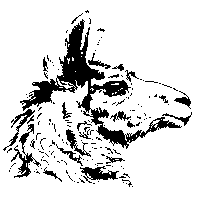The Mongolian gerbil, Meriones unguiculatus, is a rodent that is native to the desert regions of Mongolia and northeastern China. It is curious, nearly odorless, friendly, smart and easily trainable. Gerbils are burrowers, social and form monogamous pairs. In the wild, they are generally diurnal with crepuscular tendencies but in the active environment, they are mainly nocturnal, although they do have active periods in the day and consume food both day and night. They have elaborate burrows with lots of tunnels, multiple entrances, nesting rooms and food chambers where food is stored.
They come in a variety of colors and color patterns. They are legal as pets in most states but not in California, where they are forbidden by law.
[ Menu ]
Gerbils as Pets
Gerbils are friendly, curious creatures who are quiet, produce little waste , rarely bite or fight with each other, and are easily handled. Approximately half of the pet gerbils have a genetic form of epilepsy, which may show up at 2 months of age (more later). If gerbils are irritated or feel that their territory has been invaded, they will stamp there hind feet on the floor.
They are illegal to have as pets in California. Why? Gerbils do tolerate a wide range of temperatures and have very few natural diseases. Some people in agriculture feel that if they got loose and established feral colonies that they could really do a lot of damage to the California crops.
[ Menu ]
Housing
Plastic or metal cages with deep bedding are preferred, no wire cages. Bedding should be at least 1 inch deep to allow for burrow activity. If the plastic is transparent, provide at least one dark hiding place for them with no light. Gerbils are active gnawers and burrowers, so the cage must be designed to prevent escape. Escaped gerbils, however, do like to come back to their cages or may stay in the middle of the room rather than hide.
The gerbil tolerates a wide range of temperatures, 0° F to 100° F, although they prefer 65° F to 85° F. Their tolerance for heat decreases as the humidity increases. Humidity should be above 30% but below 50%.
Gerbils produce only a drop or two of urine a day, so their bedding remains very clean for a week or two without cleaning. Because they produce so little urine, they are practically odorless.
[ Menu ]
Food and Water
Gerbils are herbivores and actually prefer grains. They should have freshly milled pelleted rodent chow available to them at all times. The food must contain approximately 22% protein and should be soaked in water if the pellets are very hard. Gerbils love sunflower seeds but should not be fed these exclusively as they are low in calcium and high in fat. Adults will eat 5-8 grams of food a day. They may display food hoarding behavior.
Water must be available to gerbils at all times, adults will consume a minimum of 1-2 tsp. a day.
[ Menu ]
Life Span
The average gerbil lives for 3 years but some may live to 4 years old.
[ Menu ]
Handling, Medical Care and Epilepsy
Never pick up a gerbil by the tail, the skin can easily come off. They do not like being on their backs and will struggle to turn back over, sometimes causing the person to drop them. They can be picked up by gently scooping them up with your hand over the back and sides and keep them upright.
Gerbils have very few diseases and are very healthy. They do have a genetic form of epilepsy that is present in 50% of the pet gerbils. Only 20% of the pets will express the seizures, and contributing factors include handling, environmental changes, startling, and possible exposure to toxins. The seizures are short-lived and apparently leave no long lasting effects. Normal activity resumes usually in a few minutes. It may actually be adaptive in the wild, by preventing predators from eating them.
[ Menu ]
Web Sites
Gerbils at:
Enjoy!
 ||
||  ||
|| ![]()
